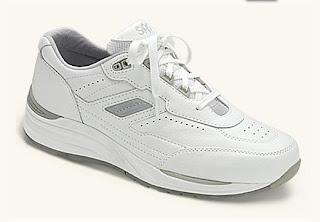Sometimes we just want to fit in with everyone else. Since the Athletic Craze hit full force in the 80's everybody wants to wear them - sometimes all the time. I always like to remind people of one thing, that is they call them Athletic Shoes for a reason. Some are made for Basketball, some are made for running, some are made for jogging, etc., etc. Most Athletic Shoe manufacturers specifically design their styles for specific sports and they are not designed for daily use. Also, they are usually only available in Medium Widths (which is O.K. if you wear a Medium Width - unfortunately many people do not).
SAS SHOEMAKERS introduced their ACTIVE COMFORT Shoes for both Men and Women in 2010. These shoes have been engineered to have the same comfort features as SAS's top selling Walking Shoes. All of these styles are available in SLIMS, NARROWS, MEDIUMS, WIDES and WIDE WIDE (with the except of Journey Grey with is not available in Slims yet) to ensure a proper fit.
TOUR (for women) is available in all over White Leather with light blue accents, Black Leather with grey accents, and a Leather Mesh Combo in White withs silver accents.
JOURNEY (for men) is available in all over White Leather with grey accents, all over Black Leather with grey accents, and a Leather/Mesh Combo in Grey. The accent colors are reflective.
 |
| TOUR for WOMEN (Shown in Leather/Mesh Combo) |
 |
| JOURNEY for MEN (Show in White) |
.
Each box includes a Product Sheet that shows what SAS has put into these shoes make them exceptional. Let's start at the bottom and work our way up.
The outsole is a flexible, durable rubber compound that is designed to provide maximum grip and comfort. The outsole is non-marking.
The shoes have SAS Steady Trac Midsoles which are shock absorbing, lightweight with forepart stabilizer that provides lateral stability. The Arcfit heel stabilizer gives a firm yet gentle support to encourage proper heel strike on all types of surfaces.
The same as SAS's walking shoes their ACTIVE COMFORT shoes have the green odor resistant Tri-pad cushions that cushion the pressure points of the feet. These lie under the Ball of the foot and heel.
SAS's new CoolStep Footbed is the best footbed to date in my opinion. This one is designed to keep your feet dry and comfortable all day long. It has an anti-friction cover that helps prevent heat buildup. The bottom layer helps wick away moisture while cushioning every step you take. It is also antibacterial and washable which will help keep your feet healthier.
Now that we have covered the four layers of cushioning and shock absorption let's move on to the uppers.
The uppers are made of Durable, Soft, Supple, Breathable Leather with plenty of ventilation to help keep your feet cool and dry. The shoes are designed with the natural shape of the foot to provide all day comfort. They have a wide wraparound heel counter to help maintain stability and SAS's exclusive EZ Lace system.
I have been wearing the Women's Leather/Mesh combo for a couple years now. I love that they are lightweight, breathable and most of all comfortable. On top of that they look good (which is always an added bonus). I even worn them to visit the Mayan Ruins on Belize in 2009. We walked for several hours and I was the only tourist who did not complain about my feet hurting.
As always, it is important to make sure you buy the proper size. When buying athletic shoes you should always make sure that the shoes are wide enough to stay comfortable at the ball of the foot and roomy enough in the front so your toes are not cramped. The heel should be snug and should not slip while walking.
SAS will not allow their shoes to be sold over the Internet, and I agree with their policy. The size and shape of your feet do change from year to year. It is important to be fitted by an expert. If you're in or near the Nashville, TN area please come by and visit Ensor's SAS Shoes, 4022 Nolensville Road, Nashville, TN 37211 (615-834-7458).












